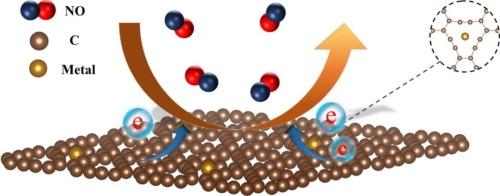Functional modulation of NO capture, detection, and storage in metal-embedded γ-graphyne systems by first-principles calculation
IF 5.1
3区 材料科学
Q2 MATERIALS SCIENCE, COATINGS & FILMS
引用次数: 0
Abstract
The capture, detection, and storage of nitric oxide (NO) are essential. This study utilizes first-principles calculations to explore how transition metals (M = Fe, Ru, Cr, V, Co, Pd, Pt) embedded in γ-graphyne (GY) influence NO adsorption, desorption, and signaling. Results demonstrate that embedding M atoms in GY forms polarized active sites, significantly enhancing NO adsorption. Charge transfer and d-p orbital hybridization reduce electronic band gaps; NO adsorption decreases magnetic moments in Fe/GY, Cr/GY, and V/GY, fully quenches those in Co/GY and Ru/GY, and induces new moments in Pd/GY via orbital hybridization. Metal modification enhances the optical response, improving dielectric function and absorption/reflectivity in the infrared-visible-near-ultraviolet region. These findings provide a basis for detecting NO adsorption through electrical, magnetic, and optical signals. Desorption dynamics indicate that Pd/GY and Pt/GY enable rapid NO release at lower temperatures, Co/GY, Fe/GY, and Cr/GY allow controlled NO desorption via thermal activation. In comparison, V/GY and Ru/GY maintain stable NO adsorption at higher temperatures, making them suitable for NO release in dynamic environments, cyclic capture-release, and storage under extreme conditions, respectively.

基于第一性原理计算的金属嵌入γ-石墨炔系统中NO捕获、检测和存储的功能调制
一氧化氮(NO)的捕获、检测和储存是必不可少的。本研究利用第一性原理计算来探索嵌入γ-石墨炔(GY)中的过渡金属(M = Fe, Ru, Cr, V, Co, Pd, Pt)如何影响NO的吸附、解吸和信号传导。结果表明,在GY中嵌入M原子形成极化活性位点,显著增强了NO的吸附。电荷转移和d-p轨道杂化减小了电子带隙;NO吸附降低了Fe/GY、Cr/GY和V/GY中的磁矩,完全淬灭了Co/GY和Ru/GY中的磁矩,并通过轨道杂化诱导了Pd/GY中的新磁矩。金属改性增强了光学响应,改善了介质功能和红外-可见-近紫外区的吸收/反射率。这些发现为通过电、磁、光信号检测NO吸附提供了基础。解吸动力学表明,Pd/GY和Pt/GY可以在较低温度下快速释放NO, Co/GY、Fe/GY和Cr/GY可以通过热活化控制NO的解吸。相比之下,V/GY和Ru/GY在较高温度下保持稳定的NO吸附,分别适用于动态环境下的NO释放、循环捕获释放和极端条件下的NO储存。
本文章由计算机程序翻译,如有差异,请以英文原文为准。
求助全文
约1分钟内获得全文
求助全文
来源期刊

Diamond and Related Materials
工程技术-材料科学:综合
CiteScore
6.00
自引率
14.60%
发文量
702
审稿时长
2.1 months
期刊介绍:
DRM is a leading international journal that publishes new fundamental and applied research on all forms of diamond, the integration of diamond with other advanced materials and development of technologies exploiting diamond. The synthesis, characterization and processing of single crystal diamond, polycrystalline films, nanodiamond powders and heterostructures with other advanced materials are encouraged topics for technical and review articles. In addition to diamond, the journal publishes manuscripts on the synthesis, characterization and application of other related materials including diamond-like carbons, carbon nanotubes, graphene, and boron and carbon nitrides. Articles are sought on the chemical functionalization of diamond and related materials as well as their use in electrochemistry, energy storage and conversion, chemical and biological sensing, imaging, thermal management, photonic and quantum applications, electron emission and electronic devices.
The International Conference on Diamond and Carbon Materials has evolved into the largest and most well attended forum in the field of diamond, providing a forum to showcase the latest results in the science and technology of diamond and other carbon materials such as carbon nanotubes, graphene, and diamond-like carbon. Run annually in association with Diamond and Related Materials the conference provides junior and established researchers the opportunity to exchange the latest results ranging from fundamental physical and chemical concepts to applied research focusing on the next generation carbon-based devices.
 求助内容:
求助内容: 应助结果提醒方式:
应助结果提醒方式:


